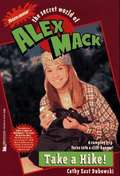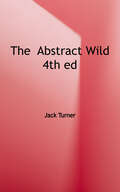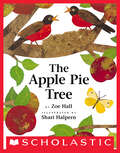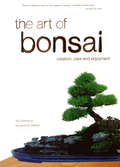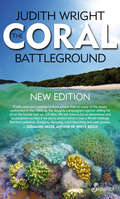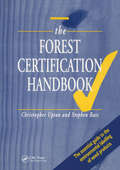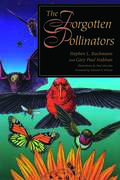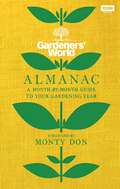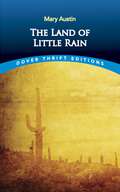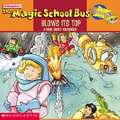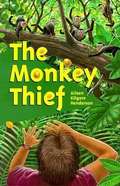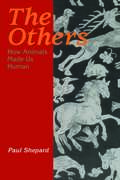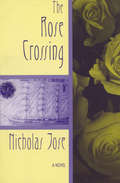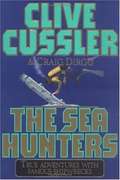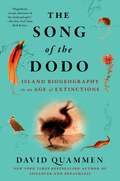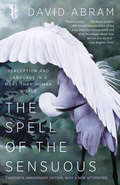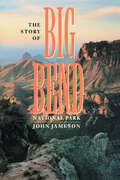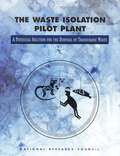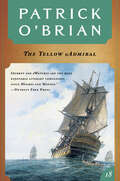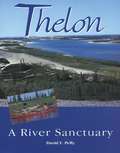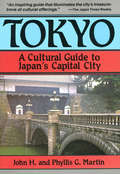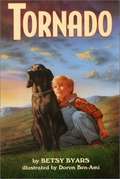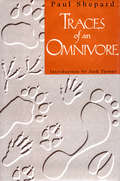- Table View
- List View
Take A Hike! (The Secret World Of Alex Mack #7)
by Cathy East DubowskiTrouble in Paradise The Junior High School Science and Nature Club is sponsoring a weekend camping trip as their end-of-year project. Alex needs the extra credit in science. What she doesn't need are the chaperones-her parents! And just to make the trip a complete disaster, Vince and Dave are loose in the woods, dead- set on nailing the GC-161 kid. With the help of her friends, Alex actually has some fun and gets a little closer to Scott. This trip is looking up...until Kelly leads them off the trail and straight into Vince and Dave's trap! Now Alex has to find a way out of the woods...and out of danger!
The Abstract Wild
by Jack TurnerIf anything is endangered in America it is our experience of wild nature—gross contact. There is knowledge only the wild can give us, knowledge specific to it, knowledge specific to the experience of it. These are its gifts to us. <p><p>How wild is wilderness and how wild are our experiences in it, asks Jack Turner in the pages of The Abstract Wild. His answer: not very wild. National parks and even so-called wilderness areas fall far short of offering the primal, mystic connection possible in wild places. And this is so, Turner avows, because any managed land, never mind what it's called, ceases to be wild. Moreover, what little wildness we have left is fast being destroyed by the very systems designed to preserve it. <p><p>Natural resource managers, conservation biologists, environmental economists, park rangers, zoo directors, and environmental activists: Turner's new book takes aim at these and all others who labor in the name of preservation. He argues for a new conservation ethic that focuses less on preserving things and more on preserving process and "leaving things be." He takes off after zoos and wilderness tourism with a vengeance, and he cautions us to resist language that calls a tree "a resource" and wilderness "a management unit." <p><p>Eloquent and fast-paced, The Abstract Wild takes a long view to ask whether ecosystem management isn't "a bit of a sham" and the control of grizzlies and wolves "at best a travesty." Next, the author might bring his readers up-close for a look at pelicans, mountain lions, or Shamu the whale. From whatever angle, Turner stirs into his arguments the words of dozens of other American writers including Thoreau, Hemingway, Faulkner, and environmentalist Doug Peacock. We hunger for a kind of experience deep enough to change our selves, our form of life, writes Turner. Readers who take his words to heart will find, if not their selves, their perspectives on the natural world recast in ways that are hard to ignore and harder to forget.
The Apple Pie Tree
by Zoe HallWe have a special tree in our yard -- an apple pie tree!Colorful collage illustrations follow each season as an apple tree grows leaves, fragrant blossoms, and tiny green apples. Soon the fruit is big, red, and ready to be picked. It's time to make an apple pie! Here is a celebration of apples and how things grow -- sure to delight young readers all year long.
The Art of Bonsai
by Giovanna M. Halford Yuji YoshimuraLearn the ins and outs of proper bonsai design and care with this comprehensive Japanese gardening book.Japanese bonsai have long been admired throughout the world while their care and preservation have seemed shrouded in mystery. The Art of Bonsai is, however, a comparatively simple art to learn. Anyone with a love a plants, a little patience and this eminently practical book can create bonsai and keep a finished plant healthy and vigorous for generations.Included in this definitive volume are:Detailed, illustrated instructions on propagation and trainingHints for those growing bonsai in a hurry and apartment dwellersDaily and seasonal bonsai care practicesDealing with pests and bonsai troubleshootingHow to judge, select and exhibit bonsaiDetailed appendices on tools, equipment, soil analysesData on more than 300 species of plants used in making bonsaiThis classic work remains an eminently practical book and is the classic guide to bonsai care. It contains the essentials of an art that is one of Japan's most treasured traditions--sculpting beauty in living wood.
The Cambridge Star Atlas
by Wil TirionThe Cambridge Star Atlas covers the entire sky, both northern and southern latitudes, in an attractive format that is suitable for beginners and experienced astronomical observers. There is a series of monthly sky charts, followed by an atlas of the whole sky, arranged in 20 overlapping full colour charts. Each chart shows stars down to magnitude 6. 5, together with about 900 non-stellar objects, such as clusters and galaxies, which can be seen with binoculars or a small telescope. There is a comprehensive map of the Moon's surface, showing craters and other named features. Wil Tirion is the world's foremost designer of astronomical maps. For this new edition he has devised improved versions of all the charts, and the text and star data have been completely revised based on the latest information. Clear, authoritative and easy-to-use, The Cambridge Star Atlas is an ideal reference atlas for sky watchers everywhere.
The Coral Battleground
by Judith WrightThe Great Barrier Reef lies off the coast of Queensland: 2000 kilometres of spectacular coral reefs, sand cays and islands, Australia's most precious marine possession. Teeming with life, it covers 350,000 square kilometres. In the late 1960s the Reef was threatened with limestone mining and oil drilling. A small group of dedicated conservationists in Queensland - John Büsst, Judith Wright, Len Webb and others - battled to save the Ellison Reef from coral-limestone mining and the Swain Reefs from oil exploration. The group later swelled to encompass scientists, trade unionists and politicians throughout Australia, and led in 1976 to the establishment of a guardian body: the Great Barrier Reef Marine Park Authority.That it still survives is a legacy of activists, artists, poets, ecologists and students. In 1967 they were branded as 'cranks'; now they should be recognised as 'visionaries'.
The Environmental Imagination: Thoreau, Nature Writing, and the Formation of American Culture (Wiley-blackwell Manifestos Ser.)
by Lawrence BuellWith the environmental crisis comes a crisis of the imagination, a need to find new ways to understand nature and humanity's relation to it. This is the challenge Lawrence Buell takes up in The Environmental Imagination, the most ambitious study to date of how literature represents the natural environment. With Thoreau's Walden as a touchstone, Buell gives us a far-reaching account of environmental perception, the place of nature in the history of western thought, and the consequences for literary scholarship of attempting to imagine a more "ecocentric" way of being. In doing so, he provides a major new understanding of Thoreau's achievement and, at the same time, a profound rethinking of our literary and cultural reflections on nature. The green tradition in American writing commands Buell's special attention, particularly environmental nonfiction from colonial times to the present. In works by writers from Crevecoeur to Wendell Berry, John Muir to Aldo Leopold, Rachel Carson to Leslie Silko, Mary Austin to Edward Abbey, he examines enduring environmental themes such as the dream of relinquishment, the personification of the nonhuman, an attentiveness to environmental cycles, a devotion to place, and a prophetic awareness of possible ecocatastrophe. At the center of this study we find an image of Walden as a quest for greater environmental awareness, an impetus and guide for Buell as he develops a new vision of environmental writing and seeks a new way of conceiving the relation between human imagination and environmental actuality in the age of industrialization. Intricate and challenging in its arguments, yet engagingly and elegantly written, The Environmental Imagination is a major work of scholarship, one that establishes a new basis for reading American nature writing.
The Forest Certification Handbook
by Christopher UptonFrom forester to retailer, stakeholders in the industry are under increasing pressure to assure customers that their wood products have come from well managed, sustainable forests. The Forest Certification Handbook gives practical advice on developing, selecting and operating a certification programme which provides both market security and raises standards of forestry management. It provides a thorough analysis of all the issues surrounding certification, including the commercial benefits to be gained, the policy mechanisms required, the interpretation and implementation of forestry management standards, and the process of certification itself. Three unique directories give details of currently certified forests, international and national initiatives, and active certification programmes.
The Forgotten Pollinators: Dynamics And Restoration Of Abandoned Farmland
by Gary Paul Nabhan Paul Mirocha Stephen L. BuchmannConsider this: Without interaction between animals and flowering plants, the seeds and fruits that make up nearly eighty percent of the human diet would not exist.In The Forgotten Pollinators, Stephen L. Buchmann, one of the world's leading authorities on bees and pollination, and Gary Paul Nabhan, award-winning writer and renowned crop ecologist, explore the vital but little-appreciated relationship between plants and the animals they depend on for reproduction -- bees, beetles, butterflies, hummingbirds, moths, bats, and countless other animals, some widely recognized and other almost unknown.Scenes from around the globe -- examining island flora and fauna on the Galapagos, counting bees in the Panamanian rain forest, witnessing an ancient honey-hunting ritual in Malaysia -- bring to life the hidden relationships between plants and animals, and demonstrate the ways in which human society affects and is affected by those relationships. Buchmann and Nabhan combine vignettes from the field with expository discussions of ecology, botany, and crop science to present a lively and fascinating account of the ecological and cultural context of plant-pollinator relationships.More than any other natural process, plant-pollinator relationships offer vivid examples of the connections between endangered species and threatened habitats. The authors explain how human-induced changes in pollinator populations -- caused by overuse of chemical pesticides, unbridled development, and conversion of natural areas into monocultural cropland-can have a ripple effect on disparate species, ultimately leading to a "cascade of linked extinctions."
The Gardeners’ World Almanac: A month-by-month guide to your gardening year
by Gardeners' World MagazineThe team at Gardeners' World bring you the ultimate guide to your gardening year, from planning and planting to troubleshooting tips and gardening discovery. Organised by month, this book includes lists, timetables, step-by-step guidance and expert advice for year-round gardening, as well as an informative guide on what to plant when and projects for every season. Complemented by beautiful hand-drawn illustrations and tips from your favourite gardening personalities, The Gardeners' World Almanac will help you make your garden look its very best throughout the year.
The Land of Little Rain (Dover Thrift Editions: Nature/Environment)
by Mary AustinThe enduring appeal of the desert is strikingly portrayed in this poetic study, which has become a classic of the American Southwest. First published in 1903, it is the work of Mary Austin (1868-1934), a prolific novelist, poet, critic, and playwright, who was also an ardent early feminist and champion of Indians and Spanish-Americans. She is best known today for this enchanting paean to the vast, arid, yet remarkably beautiful lands that lie east of the Sierra Nevadas, stretching south from Yosemite through Death Valley to the Mojave Desert.Comprising fourteen sketches, the book describes plants, animals, mountains, birds, skies, Indians, prospectors, towns, and other aspects of the desert in serene, beautifully modulated prose that conveys the timeless cycles of life and death in a harsh land. Readers will never again think of the desert as a lifeless, barren environment but rather as a place of rare, austere beauty, rich in plant and animal life, weaving a lasting spell over its human inhabitants.
The Magic School Bus Blows Its Top! A Book about Volcanoes
by Joanna Cole Gail HermanMs. Frizzle's class is having a hard time putting together a giant globe of the world. A piece is missing. . . an island so new it hasn't been discovered yet! Before they know it, the kids are beneath the oceans's surface, exploring an underwater volcano. Join the class as they learn about volcanoes.
The Monkey Thief
by Aileen Kilgore HendersonWhile visiting his uncle in a Costa Rican rain forest, Steve meets a monkey which he wants to tame and a smuggler who forces him to some very responsible decisions.
The Others: How Animals Made Us Human
by Paul ShepardPaul Shepard has been one of the most brilliant and original thinkers in the field of human evolution and ecology for more than forty years. His thought-provoking ideas on the role of animals in human thought, dreams, personal identity, and other psychological and religious contexts have been presented in a series of seminal writings, including Thinking Animals, The Tender Carnivore and the Sacred Game, and now The Others, his most eloquent book to date.The Others is a fascinating and wide-ranging examination of how diverse cultures have thought about, reacted to, and interacted with animals. Shepard argues that humans evolved watching other animal species, participating in their world, suffering them as parasites, wearing their feathers and skins, and making tools of their bones and antlers. For millennia, we have communicated their significance by dancing, sculpting, performing, imaging, narrating, and thinking them. The human species cannot be fully itself without these others.Shepard considers animals as others in a world where otherness of all kinds is in danger, and in which otherness is essential to the discovery of the true self. We must understand what to make of our encounters with animals, because as we prosper they vanish, and ultimately our prosperity may amount to nothing without them.
The Rose Crossing: A Novel
by Nicholas Jose&“A fable, set in the 17th century, filled with vivid evocations of another time [and] wonderfully peculiar characters.&” —Kirkus Reviews To escape Puritan England, naturalist Edward Popple signs on to be a ship&’s doctor on a journey across the Indian Ocean, and his daughter, Rosamund, stows away to accompany him. But a wreck leaves them stranded on an island off the coast of Africa. Amid the lush vegetation, the birds and the sea turtles, father and daughter set about exploring, Edward passionately studying the island&’s horticulture and Rosamund wandering about to discover its mysteries. Then a Chinese ship, with the last heir to the Ming dynasty among its passengers, arrives—and changes everything. &“The prose is ripe, laden with a sense of the forbidden, and with doom.&” —Publishers Weekly &“A luminous historical novel.&” —Booklist Online
The Sea Hunters I: True Adventures with Famous Shipwrecks
by Clive CusslerA nonfiction work by the creator of Dirk Pitt, this book tells thirteen tales of searches for shipwrecks. The circumstances surrounding each are described in detail along with the searches. This book reads like a novel. Among the shipwrecks are the C.S.S. Hunley, a confederate submarine-- the first to sink a ship in battle, The Leopoldville, a troop transport torpedoed by a German U-boat on Christmas eve, 1944 and the discovery of U-20, the German sub that sank the Lusitania in 1915.
The Song of the Dodo: Island Biogeography in an Age of Extinctions
by David QuammenDavid Quammen's book, The Song of the Dodo, is a brilliant, stirring work, breathtaking in its scope, far-reaching in its message -- a crucial book in precarious times, which radically alters the way in which we understand the natural world and our place in that world. It's also a book full of entertainment and wonders. In The Song of the Dodo, we follow Quammen's keen intellect through the ideas, theories, and experiments of prominent naturalists of the last two centuries. We trail after him as he travels the world, tracking the subject of island biogeography, which encompasses nothing less than the study of the origin and extinction of all species. Why is this island idea so important? Because islands are where species most commonly go extinct -- and because, as Quammen points out, we live in an age when all of Earth's landscapes are being chopped into island-like fragments by human activity. Through his eyes, we glimpse the nature of evolution and extinction, and in so doing come to understand the monumental diversity of our planet, and the importance of preserving its wild landscapes, animals, and plants. We also meet some fascinating human characters. By the book's end we are wiser, and more deeply concerned, but Quammen leaves us with a message of excitement and hope.
The Spell of the Sensuous: Perception and Language in a More-than-Human World
by David AbramAnimal tracks, word magic, the speech of stones, the power of letters, and the taste of the wind all figure prominently in this intellectual tour de force that returns us to our senses and to the sensuous terrain that sustains us. This is a major work of ecological philosophy that startles the senses out of habitual ways of perception.
The Story of Big Bend National Park
by John JamesonThe history of the first national park in Texas—the politics, intrigues, controversies, and the people inspired by the stunning desert environment. A breathtaking country of rugged mountain peaks, uninhabited desert, and spectacular river canyons, Big Bend is one of the United States&’ most remote national parks and among Texas&’ most popular tourist attractions. Located in the great bend of the Rio Grande that separates Texas and Mexico, the park comprises some 800,000 acres, an area larger than the state of Rhode Island, and draws over 300,000 visitors each year. The Story of Big Bend National Park offers a comprehensive, highly readable history of the park from before its founding in 1944 up to the present. John Jameson opens with a fascinating look at the mighty efforts involved in persuading Washington officials and local landowners that such a park was needed. He details how money was raised and land acquired, as well as how the park was publicized and developed for visitors. Moving into the present, he discusses such issues as natural resource management, predator protection in the park, and challenges to land, water, and air. Along the way, he paints colorful portraits of many individuals, from area residents to park rangers to Lady Bird Johnson, whose 1966 float trip down the Rio Grande brought the park to national attention. This history will be required reading for all visitors and prospective visitors to Big Bend National Park. For everyone concerned about our national parks, it makes a persuasive case for continued funding and wise stewardship of the parks as they face the twin pressures of skyrocketing attendance and declining budgets.
The Waste Isolation Pilot Plant: A Potential Solution for the Disposal of Transuranic Waste
by Committee on the Waste Isolation Pilot PlantThis volume discusses the readiness of the U.S. Department of Energy's (DOE) Waste Isolation Pilot Plant (WIPP) facility near Carlsbad, New Mexico, to serve as a geological repository for transuranic radioactive waste. WIPP is located in a Permian-age bedded salt deposit 658 meters below the surface. The committee has long reviewed DOE's readiness efforts, now aimed at demonstrating compliance with U.S. Environmental Protection Agency regulations. Site characterization studies and performance assessment modeling are among the topics considered in this volume.
The Yellow Admiral (Aubrey/Maturin Novels #18)
by Patrick O'Brian"There are those already planning this afternoon's trip to the bookstore. Their only reaction is: Thank god, Patrick O'Brian is still writing. To you, I say, not a moment to lose."—John Balzar, Los Angeles Times Life ashore may once again be the undoing of Jack Aubrey in The Yellow Admiral, Patrick O'Brian's best-selling novel and eighteenth volume in the Aubrey/Maturin series. Aubrey, now a considerable though impoverished landowner, has dimmed his prospects at the Admiralty by his erratic voting as a Member of Parliament; he is feuding with his neighbor, a man with strong Navy connections who wants to enclose the common land between their estates; he is on even worse terms with his wife, Sophie, whose mother has ferreted out a most damaging trove of old personal letters. Even Jack's exploits at sea turn sour: in the storm waters off Brest he captures a French privateer laden with gold and ivory, but this at the expense of missing a signal and deserting his post. Worst of all, in the spring of 1814, peace breaks out, and this feeds into Jack's private fears for his career. Fortunately, Jack is not left to his own devices. Stephen Maturin returns from a mission in France with the news that the Chileans, to secure their independence, require a navy, and the service of English officers. Jack is savoring this apparent reprieve for his career, as well as Sophie's forgiveness, when he receives an urgent dispatch ordering him to Gibraltar: Napoleon has escaped from Elba.
Thelon: A River Sanctuary
by David F. PellyDavid Pelly tells the Thelon’s story, exploring the mystery of Man’s relationship with this special place in the heart of Canada’s vast Arctic barrenlands. From Thanadelthur and Telaruk to J.W. Tyrrell, John Hornby and Eric Morse, the history is detailed, complete and exciting. The Thelon is the setting for a compelling Canadian adventure tale – with all its drama, intrigue, joy and tragedy. But the writer goes beyond that to contemplate the significance of the Thelon wilderness, and to examine its uncertain future."It is the richness of human experience, layered on top of the natural splendour of the river valley and its wildlife, that really sets the Thelon apart. The place has a history, both Native and non-Native, which gives it standing beyond the intrinsic value of wilderness itself."David Pelly writes as one who has been there time and again. He knows the Thelon from personal experience. As a freelance writer for 20 years, he has travelled many parts of the Arctic, but claims that "nowhere draws me back more powerfully than the Thelon."
Tokyo a Cultural Guide to Japan's Capital City
by John H. Martin Phyllis G. MartinDiscover, in a series of linked, engaging half-day excursions, the stories behind places like Hibiya's Hall of the Cry of the Stag and "Flying Head" of Marunouchi. Visit the sites where the Forty-Seven Ronin, the "last Samurai" General Nogi, and Yukio Mishima committed ritual Seppuku. In the sumo district see where the wrestlers fight, train and live, and just a bit farther on, the massive Thunder Gate of Senso-ji Temple.John and Phyllis Martin have visited Tokyo numerous times and know the city intimately. With detailed directions and maps, they introduce the background, the legends, and the sights that bring old Edo alive.
Tornado
by Betsy ByarsA tornado is coming, and once Pete the farmhand gathers the family safely in the storm cellar, he distracts them with a favorite tale about a tornado from his childhood--and the surprise it brought: Among the debris left by this twister was a doghouse, complete with a dog inside! Pete goes on to tell more stories about this hole-digging, cardtrick-playing dog, aptly named Tornado; and it isn't hard to see how Tornado, and the stories about him, soon become a part of both past and present families.
Traces of an Omnivore
by Jack Turner Paul ShepardPaul Shepard is one of the most profound and original thinkers of our time. He has helped define the field of human ecology, and has played a vital role in the development of what have come to be known as environmental philosophy, ecophilosophy, and deep ecology -- new ways of thinking about human-environment interactions that ultimately hold great promise for healing the bonds between humans and the natural world. Traces of an Omnivore presents a readable and accessible introduction to this seminal thinker and writer. Throughout his long and distinguished career, Paul Shepard has addressed the most fundamental question of life: Who are we? An oft-repeated theme of his writing is what he sees as the central fact of our existence: that our genetic heritage, formed by three million years of hunting and gathering remains essentially unchanged. Shepard argues that this, "our wild Pleistocene genome," influences everything from human neurology and ontogeny to our pathologies, social structure, myths, and cosmology. While Shepard's writings travel widely across the intellectual landscape, exploring topics as diverse as aesthetics, the bear, hunting, perception, agriculture, human ontogeny, history, animal rights, domestication, post-modern deconstruction, tourism, vegetarianism, the iconography of animals, the Hudson River school of painters, human ecology, theoretical psychology, and metaphysics, the fundamental importance of our genetic makeup is the predominant theme of this collection. As Jack Turner states in an eloquent and enlightening introduction, the essays gathered here "address controversy with an intellectual courage uncommon in an age that exults the relativist, the skeptic, and the cynic. Perused with care they will reward the reader with a deepened appreciation of what we so casually denigrate as primitive life -- the only life we have in the only world we will ever know."
